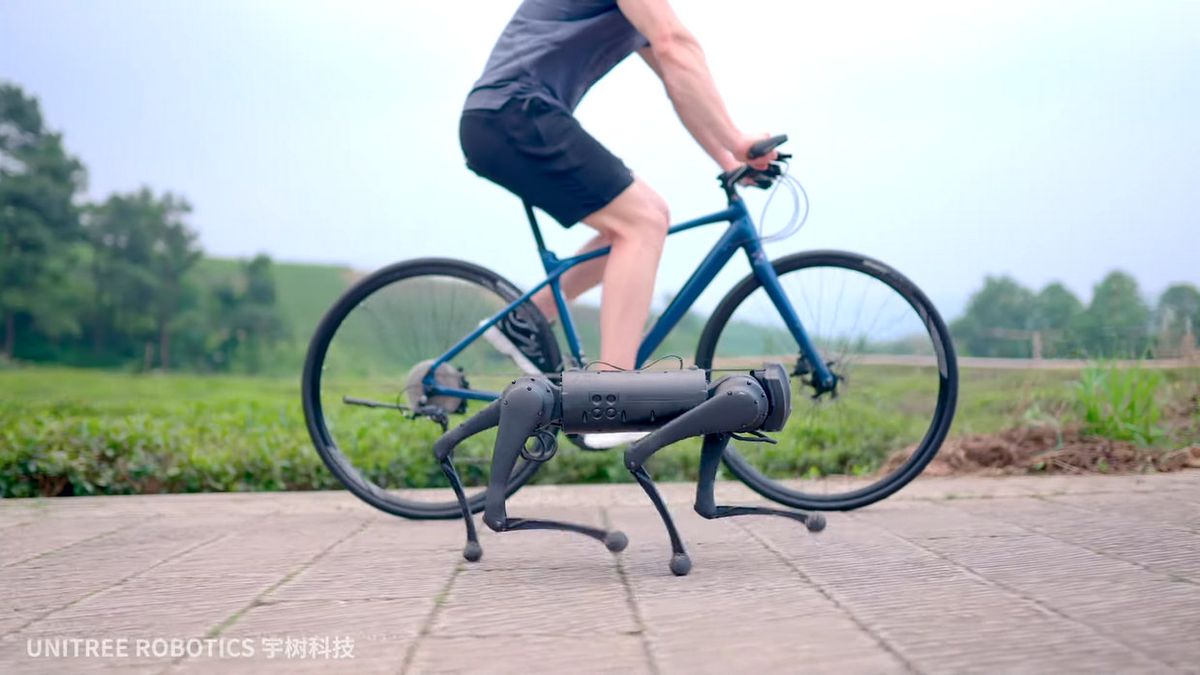In 2017, we first wrote about the Chinese startup Unitree Robotics, which had the goal of “making legged robots as popular and affordable as smartphones and drones.” Relative to the cost of other quadrupedal robots (like Boston Dynamics’ $74,000 Spot), Unitree’s quadrupeds are very affordable, with their A1 costing under $10,000 when it became available in 2020. This hasn’t quite reached the point of consumer electronics that Unitree is aiming for, but they’ve just gotten a lot closer: now available is the Unitree Go1, a totally decent looking small size quadruped that can be yours for an astonishingly low $2700.
Not bad, right? Speedy, good looking gait, robust, and a nifty combination of autonomous human following and obstacle avoidance. As with any product video, it’s important to take everything you see here with a grain of salt, but based on Unitree’s track record we have no particular reason to suspect that there’s much in the way of video trickery going on.
There are three versions of the Go1: the $2700 base model Go1 Air, the $3500 Go1, and the $8500 Go1 Edu. This looks to be the sort of Goldilocks pricing model, where most people are likely to spring for the middle version Go1, which includes better sensing and compute as well as 50% more battery life an an extra m/s of speed (up to 3.5m/s) for a modest premium in cost. The top of the line Edu model offers higher end computing, 2kg more payload (up to 5kg), as well as foot-force sensors, lidar, and a hardware extension interface and API access. More detailed specs are here, although if you’re someone who actually cares about detailed robot specs, what you’ll find on Unitree’s website at the moment will probably be a little bit disappointing.
We’ve reached out to Unitree to ask them about some of the specs that aren’t directly addressed on the website. Battery life is a big question—the video seems to suggest that the Go1 is capable of a three-kilometer, 20-minute jog, and then some grocery shopping and a picnic, all while doing obstacle avoidance and person following and with an occasional payload. If all of that is without any battery swaps, that’s pretty good. We’re also wondering exactly what the “Super Sensory System” is, what kinds of tracking and obstacle avoidance and map making skills the Go1 has, and exactly what capabilities you’ll be required to spring for the fancier (and more expensive) versions of the Go1 to enjoy.
Honestly, though, we’re not sure what Unitree could realistically tell us about the Go1 where we’d be like, “hmm okay maybe this isn’t that great of a deal after all.” Of course the real test will be when some non-Unitree folks get a hold of a Go1 to see what it can actually do (Unitree, please contact me for my mailing address), but even at $3500 for the midrange model, this seems like an impressively cost effective little robot.
Update: we contacted Unitree for more details, and they’ve also updated the Go1 website to include the following:
- The battery life of the robot while jogging is about 1 hour
- It weighs 12kg
- The Super Sensory System includes five wide-angle stereo depth cameras, hypersonic distance sensors, and an integrated processing system
- It’s running at 16 core CPU and a 1.5 tflop GPU
We also asked Wang Xingxing, Unitree’s CEO, about how they were able to make Go1 so affordable, and here’s what he told us:
Unitree Go1 can be regarded as a product that we have achieved after 6-7 years of iteration at the hardware level, only to achieve the goals of ultra-low cost, high reliability and high performance. Our company actually spent more manpower and money than software on the hardware level such as machinery.
Evan Ackerman is a senior editor at IEEE Spectrum. Since 2007, he has written over 6,000 articles on robotics and technology. He has a degree in Martian geology and is excellent at playing bagpipes.



